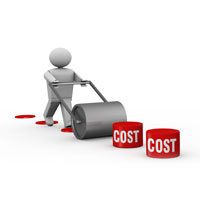
I really doubt anyone likes paying for auto insurance, in particular when they could lower their rates if they shopped around. Due to the fact that there are so many insurance providers from which to choose, it’s difficult to choose the best auto insurance company.
Find hidden discounts to get affordable auto insurance rates
Auto insurance is not inexpensive, but you might already qualify for some discounts that can help lower your rates. Many of these discounts will be applied automatically at the time of purchase, but some must be asked about before they will apply.
- Responsible Driver Discounts – Drivers without accidents could pay up to 40% less for 100 insurance compared to accident prone drivers.
- Military Rewards – Being on active duty in the military could trigger a small discount.
- Pay Now and Pay Less – By paying your entire bill at once instead of monthly or quarterly installments you can avoid monthly service charges.
- Auto/Home Discount – When you have multiple policies with one company you will save nearly 15% which can help you find .
- Membership in Organizations – Joining a qualifying organization can get you a small discount when getting a .
- Air Bag Discount – Factory options such as air bags or automatic seat belts can qualify for discounts of up to 25% or more.
While discounts sound great, it’s important to understand that most discounts do not apply to all coverage premiums. Most only cut individual premiums such as physical damage coverage or medical payments. Just because you may think you could get a free auto insurance policy, company stockholders wouldn’t be very happy.
A list of auto insurance companies and a summarized list of policyholder discounts can be read below.
- Progressive may have discounts that include online signing, continuous coverage, multi-vehicle, homeowner, multi-policy, good student, and online quote discount.
- AAA includes discounts for anti-theft, AAA membership discount, multi-policy, good student, good driver, pay-in-full, and education and occupation.
- Farmers Insurance policyholders can earn discounts including business and professional, good student, early shopping, bundle discounts, switch companies, homeowner, and teen driver.
- GEICO may include discounts for membership and employees, multi-vehicle, five-year accident-free, multi-policy, seat belt use, and anti-lock brakes.
- Esurance offers discounts including good student, anti-theft, anti-lock brakes, claim free, defensive driver, Pac-12 alumni, and multi-car.
- SAFECO has savings for anti-theft, teen safety rewards, anti-lock brakes, multi-car, and teen safe driver.
- State Farm has discounts for Drive Safe & Save, good student, accident-free, multiple autos, and driver’s education.
It’s a good idea to ask all companies you are considering which discounts you qualify for. Some discounts listed above might not be offered on policies in your area. If you would like to view companies with discount rates, click this link.
Drivers who switch save $436 a year? Really?
Consumers get pounded daily by advertisements that claim the best premium rates from the likes of GEICO, State Farm and Progressive. All the companies advertise claims about saving some big amount if you just switch to them.
It sounds good, but how can they all say the same thing? It’s all in the words they use.
Insurance companies have an ideal profile for the right customer they prefer to insure. For example, a profitable risk profile may need to be over age 30, insures multiple vehicles, and has a high credit rating. A driver that meets those criteria will get the preferred car insurance rates and is almost guaranteed to cut their rates substantially.
People who don’t measure up to these stringent criteria will see a more expensive rate and this results in business going elsewhere. If you listen to the ad wording, they say “customers that switch” but not “everyone who gets a quote” save that much when switching. That’s the way companies can truthfully make it sound like they have such great car insurance rates.
That is why you absolutely need to quote coverage with many companies. It’s just not possible to know which company will have better rates than you’re paying now.
Auto insurance policy specifics
Having a good grasp of a auto insurance policy aids in choosing which coverages you need for your vehicles. Policy terminology can be impossible to understand and nobody wants to actually read their policy. These are the usual coverages found on most auto insurance policies.
Comprehensive coverage (or Other than Collision)
This coverage pays to fix your vehicle from damage caused by mother nature, theft, vandalism and other events. You first must pay your deductible and the remainder of the damage will be paid by comprehensive coverage.
Comprehensive insurance covers claims like hitting a deer, damage from getting keyed, hail damage and hitting a bird. The most your auto insurance company will pay is the ACV or actual cash value, so if the vehicle’s value is low consider dropping full coverage.
Liability coverages
Liability coverage provides protection from damage that occurs to other people or property by causing an accident. Liability coverage has three limits: bodily injury per person, bodily injury per accident and property damage. You commonly see values of 100/300/100 that means you have $100,000 bodily injury coverage, a per accident bodily injury limit of $300,000, and a total limit of $100,000 for damage to vehicles and property. Occasionally you may see a combined limit that pays claims from the same limit rather than limiting it on a per person basis.
Liability coverage protects against claims like legal defense fees, attorney fees and medical services. How much coverage you buy is up to you, but it’s cheap coverage so purchase as much as you can afford.
Collision coverage protection
This will pay to fix damage to your 100 resulting from a collision with another vehicle or an object, but not an animal. You have to pay a deductible then the remaining damage will be paid by your insurance company.
Collision insurance covers things like driving through your garage door, hitting a parking meter, sustaining damage from a pot hole and damaging your car on a curb. Collision coverage makes up a good portion of your premium, so you might think about dropping it from vehicles that are older. It’s also possible to raise the deductible to bring the cost down.
Uninsured Motorist or Underinsured Motorist insurance
This gives you protection when the “other guys” are uninsured or don’t have enough coverage. Covered claims include injuries to you and your family as well as damage to your Audi 100.
Since many drivers only carry the minimum required liability limits, it only takes a small accident to exceed their coverage. This is the reason having UM/UIM coverage should not be overlooked. Usually these coverages are set the same as your liablity limits.
Insurance for medical payments
Personal Injury Protection (PIP) and medical payments coverage provide coverage for immediate expenses for prosthetic devices, pain medications, X-ray expenses and surgery. They are used in conjunction with a health insurance policy or if you lack health insurance entirely. It covers both the driver and occupants as well as any family member struck as a pedestrian. Personal Injury Protection is only offered in select states but can be used in place of medical payments coverage
And the best auto insurance company is…
When getting , never skimp on coverage in order to save money. In many cases, drivers have reduced full coverage and learned later that the few dollars in savings costed them thousands. The proper strategy is to purchase plenty of coverage at the lowest possible cost.
You just read a lot of ways to get a better price on Audi 100 insurance. The key thing to remember is the more companies you get rates for, the higher the chance of saving money. Drivers may discover the lowest prices are with a company that doesn’t do a lot of advertising. Some small companies often have lower rates on specific markets as compared to the big name companies such as State Farm, GEICO and Nationwide.


